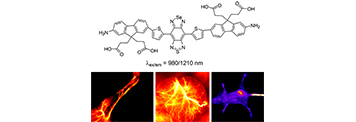|
| Insight on research |
 |
|
|
 |
|
| Huimin Ma group has made important progress in the second near-infrared spectroscopic probe |
Fluorophores in the second near-infrared window (NIR-II, 1000-1700 nm) have attracted extensive attention due to their better imaging quality and deeper tissue penetration than those in the first near-infrared window (NIR-I, 650?900 nm). Currently, NIR-II fluorophores are primarily based on inorganic nanomaterials, but their disputable toxicity hinders preclinical translation. In contrast, organic small molecular fluorophores have presented satisfactory safety profiles and have been used in ...
|
|
|
 |
|
| New spectroscopic probe and its application to fluorescence imaging of hydroxyl radical |
Development of new spectroscopic probes and specific imaging methods is of great importance for various biological studies. Prof. Ma’s research group at the Institute of Chemistry, Chinese Academy of Sciences (ICCAS), has been engaged in this area for more than 20 years, during which a series of new spectroscopic probes and sensing methods for bioactive species have been developed by using various chemical reactions. Based on their important results, Prof. Ma and his colleagues have been inv...
|
|
|
 |
|
| New spectroscopic probe and its use in fluorescence imaging of monoamine oxidase A |
Because of their high sensitivity and spatiotemporal resolution, excellent spectroscopic (chromogenic, fluorescent, or chemiluminescent) probes have attracted much attention. Prof. Ma’s research group at the Institute of Chemistry, Chinese Academy of Sciences, has been engaged in this field for more than two decades, during which a series of new spectroscopic probes and sensing/labeling methods for biologically active species have been developed by employing different chemical reactions. Bas...
|
|
|
 |
|
| New spectroscopic probe and its use in fluorescence imaging of tyrosinase activity |
Due to the high sensitivity and high spatiotemporal resolution, the development of excellent spectroscopic (chromogenic, fluorescent, or chemiluminescent) probes has attracted much attention. Prof. Ma’s research group at the Institute of Chemistry, Chinese Academy of Sciences, has been engaged in this field for more than two decades, during which a series of new spectroscopic probes and sensing/labeling methods for biologically active species have been developed by employing different chemic...
|
|
|
|
|
|
